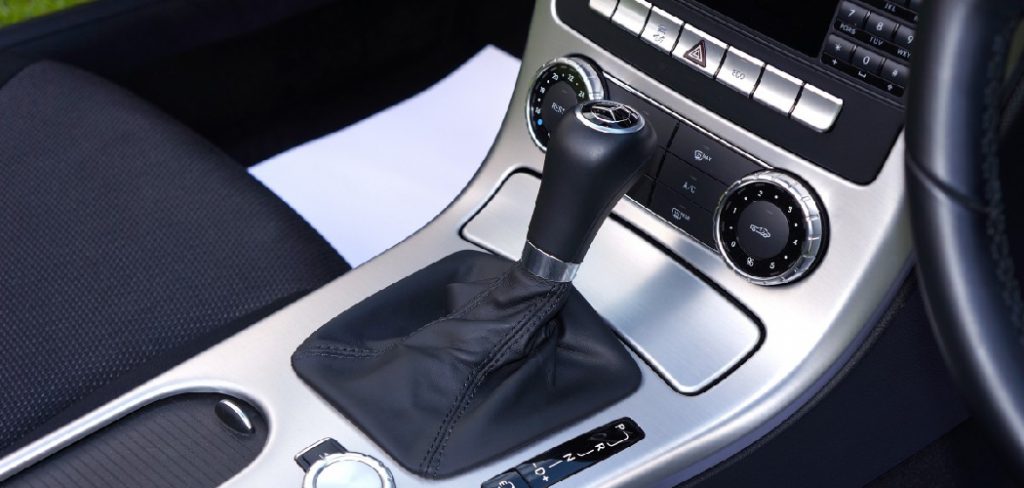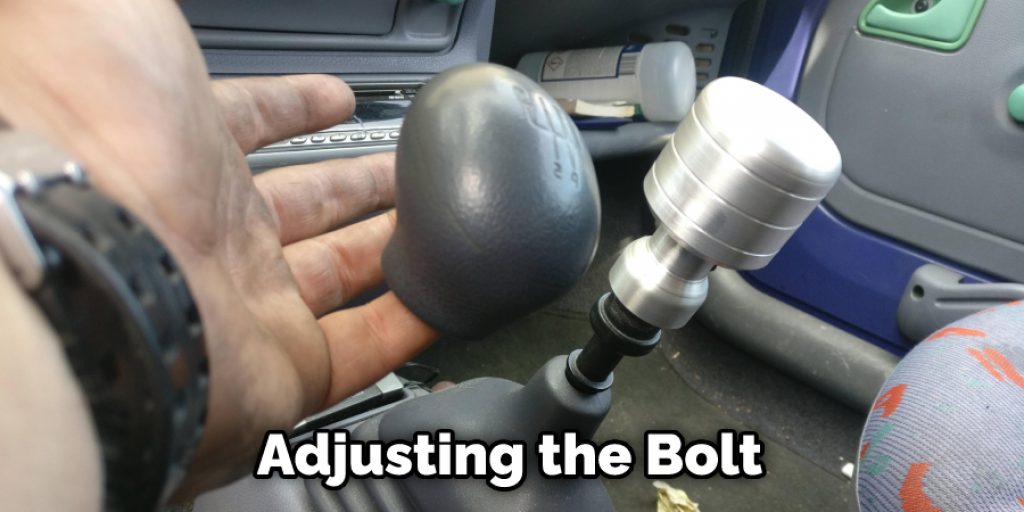Shifting gears in your car should be a seamless process, but sometimes you may find that your gear shifter is loose. If this is the case, you can do a few things to fix it. Keep reading to learn how to fix a loose gear shifter automatic.

Summary: This blog post outlines a step-by-step guide on how to fix a loose gear shifter automatic. It provides instructions on diagnosing the troublesome source, removing nuts and bolts, using thread locker, turning the gear shifter knob and removing the gear shifter retaining ring. Finally, it advises putting back the bolts for a successful repair.
Why Loose Gear Shifter
The most common reasons for a loose gear shifter are a worn-out gear shifter bushing or a loose gearshift lever. Another possible reason your gear shifter may be loose is because the screws or bolts that hold it in place are loose.
If your gear shifter is loose, it might be due to a worn-out gear shifter bushing. This bushing is what the gear shift lever sits in, and over time it can become worn down. If that’s the case, you can tighten it up yourself.
How to Fix a Loose Gear Shifter Automatic Step by Step Guide
Step 1: Gather Necessary Tools and Materials
Before attempting to fix a loose gear shifter in an automatic vehicle, gather the following tools and materials:
- Socket set and wrench
- Screwdriver (flathead and Phillips)
- Pliers
- Replacement bushings or linkage parts (if necessary)
- Shop manual or repair guide for your specific vehicle
- Penetrating oil (optional)
- Clean cloth or rag
- Work gloves
- Safety glasses
Step 2: Consult Your Vehicle’s Shop Manual or Repair Guide
Refer to your vehicle’s shop manual or repair guide to locate and identify the components related to the gear shifter mechanism. This will provide you with a better understanding of the specific parts and their locations, as well as any special instructions or precautions to take during the repair process.
Step 3: Park Your Vehicle on a Level Surface
Park your vehicle on a level surface and engage the parking brake to ensure it remains stationary during the repair process. Turn off the engine and remove the key from the ignition.
Step 4: Locate the Shifter Linkage
In most automatic vehicles, the gear shifter is connected to the transmission through a series of rods or cables, known as the shifter linkage. This linkage is typically found underneath the vehicle, near the transmission. Put on your safety glasses and work gloves, and use a flashlight if necessary to locate the shifter linkage.
Step 5: Inspect the Shifter Linkage for Damage or Wear
Carefully inspect the shifter linkage for any visible signs of damage, wear, or loose connections. Common issues include worn or damaged bushings, loose bolts or nuts, and bent or misaligned linkage components. Make note of any problem areas you identify during your inspection.
Step 6: Tighten Loose Bolts or Nuts
If you discover any loose bolts or nuts in the shifter linkage, use the appropriate socket and wrench to tighten them securely. Be careful not to overtighten, as this can cause damage to the linkage components.
Step 7: Lubricate Stiff or Sticking Linkage Components
If any of the linkage components appear stiff or difficult to move, apply a small amount of penetrating oil to the affected areas. Use a clean cloth or rag to wipe away any excess oil, and then attempt to move the components by hand to ensure they are functioning smoothly.
Step 8: Replace Damaged or Worn Bushings
Worn or damaged bushings are a common cause of loose gear shifters in automatic vehicles. If you identified any problematic bushings during your inspection, remove them using pliers or a screwdriver, and replace them with new ones. Ensure the new bushings are properly seated and secure.
Step 9: Replace Damaged or Misaligned Linkage Components
If any of the linkage components are bent, damaged, or misaligned, they may need to be replaced. Consult your vehicle’s shop manual or repair guide for specific instructions on how to remove and replace these parts. Take care to properly align and secure any new components during the installation process.
Step 10: Reassemble the Shifter Linkage
Once all necessary repairs and adjustments have been made, reassemble the shifter linkage, ensuring that all components are properly aligned and secure. Double-check your work to confirm that there are no loose connections or other issues that could cause the gear shifter to malfunction.
Step 11: Test the Gear Shifter
Start your vehicle’s engine and test the gear shifter to ensure it is functioning correctly. Shift through all available gears, paying attention to any unusual noises or resistance. If the gear shifter still feels loose or exhibits other issues, further inspection and repair may be necessary.
Step 12: Address Any Additional Issues
If your initial repairs did not fully resolve the issue with the loose gear shifter, consider seeking help from a professional mechanic or consulting your vehicle’s shop manual or repair guide for further guidance. There may be additional issues with the transmission or other components that require attention.
Step 13: Perform Routine Maintenance
To help prevent future issues with your gear shifter, be sure to perform routine maintenance on your vehicle, including regular inspections of the shifter linkage and transmission components. Address any signs of wear or damage promptly to avoid more extensive repairs down the line.
Step 14: Stay Alert for Signs of Trouble
As you continue to drive your vehicle, stay alert for any signs that the gear shifter may be becoming loose again or experiencing other issues. This could include difficulty shifting, unusual noises, or a lack of response from the shifter. Address any concerns promptly to ensure your vehicle remains safe and reliable.
By following these steps, you can effectively fix a loose gear shifter in an automatic vehicle, restoring its functionality and improving your driving experience. Regular maintenance, timely repairs, and attentiveness to potential issues can help you avoid more significant problems in the future and keep your vehicle running smoothly. Remember that if you are ever unsure about how to proceed or are not confident in your ability to perform the necessary repairs, seeking help from a professional mechanic is always a wise choice.
Symptoms of A Problematic Gear Shifter
A few telltale signs indicate that your gear shifter is starting to loosen up and needs some attention. If you notice any of the following, it’s time to take action:
- The shifter feels loose when you move it from one position to another
- The shifter moves more than usual when you shift gears
- The shifter gets stuck in one position and won’t budge
If you’re experiencing any of these issues, don’t panic. You can do a few things to fix a loose gear shifter.
Fixing Some Shifter Problem
Tightening the Shifter Handle
If you’re experiencing a loose gear shifter automatic, the first thing is to tighten the shifter handle. You can do this by adjusting the bolt located on the shifter handle. Next, loosen the bolt with a wrench and then tighten it up. Once tightened, test to see if the shifter is now tighter. If it is, you’re good to go. If it’s still loose, move on to the next step.

Tightening the Shifter Cable
Tightening the shifter cable is easy to fix a loose gear shifter automatic. First, find the bolt that is holding the shifter cable in place. This bolt will be on the bottom of the car near where the gear shifter is located. Once you have found the bolt, loosen it and pull the shifter cable out of the car. Next, take the new shifter cable and insert it into the car. Ensure that the bolt is tightened before you put the car back together.
Tightening the Shifter Knob
If your gear shifter is loose, there’s a good chance that the knob is simply loose and needs to be tightened. To do this, you’ll need a Phillips head screwdriver. First, remove the center console panel to access the shifter knob. Then, use the screwdriver to tighten the two screws that hold the knob.
If the knob is still loose after tightening the screws, you may need to replace the shifter knob altogether. Keep reading for more information about how to fix a loose gear shifter automatic.
Some Have Necessity Tips Below
There are a few tips that you can follow if you’re experiencing a loose gear shifter automatic. The first thing you can do is check the transmission fluid level. You should also ensure that the transmission fluid is of the correct type for your car. If the transmission fluid is dirty or low, you should change it.
Another thing that you can do is to tighten the bolts that hold the gear shifter in place. If these bolts are loose, it can cause the gear shifter to become loose. You can also try spraying some lubricant on the shifter mechanism to help keep it moving smoothly. If none of these tips work, you may need to have the transmission serviced.
Be Careful About Changing Positions
The most common cause of a loose gear shifter is simply changing its position too frequently. Over time, the gear shifter will become less tight and eventually loosen up. Be careful about how often you change gears and gently return them to the same spot each time.
Avoid Over-Clogging the Bolts
One of the biggest problems with fixing a loose gear shifter automatic is over-clogging the bolts. This can cause the parts to become stuck, making it difficult or impossible to fix the problem. If this happens, you may need to take your car to a mechanic.

To avoid over-clogging the bolts, use the correct size Allen wrench. If you’re not sure what size to use, consult your car’s owner’s manual.
Odd Noises That May Come From the Gear Shifter
There are many reasons why a car may start making strange noises, and one of them could be a loose gear shifter automatic. If this is the problem, a few things can be done to fix it. One is to lubricate the shifter with some silicone or WD-40. This will help to keep it moving smoothly.
The Transmission Makes a Grinding Noise
If you’re experiencing a grinding noise when you shift gears in your automatic transmission, there are a few things you can do to try to fix the issue. The first step is to check the fluid level in your transmission and ensure it’s at the correct level. You may also need to add some additional fluid if it’s low.
The Gear Shifter Jumps Into Neutral
This is one of the most common problems with automatic transmission. It can be caused by numerous things such as low fluid levels, a malfunctioning torque converter, or a sticking valve. If the Gear Shifter Jumps Into Neutral, you will need to take your car to a mechanic to determine the cause and how to fix it.
The Grear Shifter Is Stuck in Gear
Inspect the gear shifter to see if it is loose. If it is, you will need to tighten the bolts that hold it in place. You can do this by using a wrench.
If the gear shifter is not loose, you will need to inspect the linkage that connects the gear shifter to the transmission. If there is any damage or wear on the linkage, you will need to replace it.
The transmission may also be the problem. You will need to take the car to a mechanic to have it inspected.
Frequently Asked Question
Why Is My Gear Shift Lose Automatic?
There are a few reasons why your gear shift might be loose automatic. One possibility is that the linkages or rods that connect the shifter to the transmission may be worn or broken. Another possibility is that the bushings in the shifter assembly may be worn, causing excessive slop in the system. Finally, it’s also possible that the shift selector lever in the transmission may be loose or worn.
What Causes a Shifter to Be Loose?
A few different things can cause a shifter to be loose. One of the most common causes is a lack of lubrication. When a shifter isn’t lubricated, it can become loose and move around. Another common cause of a loose shifter is wear and tear. Over time, the parts on a shifter can become worn and start to move around more. If your shifter is loose, there are a few things that you can do to fix it.
Conclusion
So there you have it, our step-by-step guide on how to fix a loose gear shifter automatic. We hope you found this information helpful and that it saves you the hassle and cost of taking your car in for repair. Have you tried any of these methods? Let us know in the comments below!
